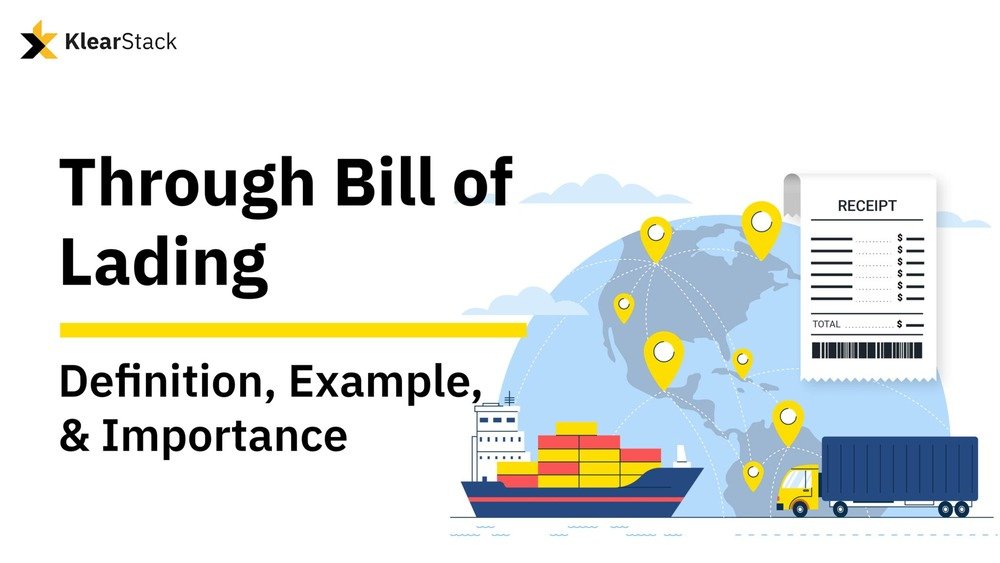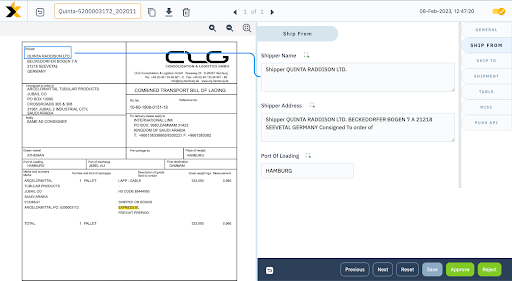Through Bill of Lading: Definition, Example, Importance

What is a Through Bill of Lading?
A Through Bill of Lading is a signed agreement between the shipper and the carrier when the shipment of goods involves multiple transportation modes. For example, the transportation mode will first be land and then sea. Through Bill of Lading is a type of Bill of Lading.
It has 3 key functions:
- It serves as a receipt that goods have been loaded.
- It also serves as evidence of the contract of carriage between the shipper and carrier.
- Through Bill of Lading is the document of title to the goods.
The agreement outlines key details such as:
- Names and details of the shipper, consignee, and carrier.
- Type, quantity, and condition specifics for accurate handling.
- Clear departure and arrival points for each stage.
- Information on land, sea, or air transport.
- A chronological record of goods handover at each stage.
Must-Read Articles:
Through Bill of Lading Example
Through Bill of Lading Example for a Shipment from Supplier to Retailer via Multiple Modes:
|
Names and Addresses: | Supplier: | XYZ Manufacturing Co. Mexico City, Mexico
Phone: [Shipper Phone], Email: [Shipper Email] |
|
Carrier: |
Global Logistics Solutions | |
| Retailer: |
ABC Retail Stores Inc. New York, USA Phone: [Shipper Phone], Email: [Shipper Email] | |
|
Description of Goods: |
500 units of apparel, with detailed specifications. | |
|
Transportation Routes: | Truck: | Mexico City to Port of Veracruz |
|
Vessel: |
Veracruz to Port of Miami | |
| Truck: |
Miami to New York | |
|
Voyage Information: | Vessel: |
Atlantic Express |
|
Voyage: | AE202304 | |
| Ports: |
Veracruz (Loading) – Miami (Transshipment) – New York (Final Destination) | |
|
Terms and Conditions: | Incoterms 2020: CIF (Cost, Insurance, Freight) | |
| Freight Charges: |
Comprehensive freight cost covering all transportation modes. | |
|
Date of Shipment: | May 23, 20XX | |
| Special Instructions or Requirements |
Temperature-sensitive goods; insurance coverage for the entire journey. | |
What is the Purpose of the Through Bill of Lading?
A Through Bill of Lading serves as a vital document in the transportation of goods, each tailored for distinct purposes. However, the Bill of Lading covers multiple modes of transportation.
For example, the Through Bill of Lading caters to the complexities of global trade and multifaceted journeys involving both sea and land transport. In contrast, the Inland Bill of Lading is confined to domestic boundaries and the Ocean Bill of Lading to the sea.
To make informed decisions—stakeholders should assess the nature, destination, and mode of transportation for their specific shipment.
They may contemplate key questions when considering a Through Bill of Lading:
- Does the shipment involve multiple modes of transport, such as sea and land?
- Are various parties engaged in the shipment, including shippers, carriers, and consignees, located in different countries?
- Are there specific legal or contractual obligations related to international shipments that necessitate compliance?
Parties Involved in a Through Bill of Lading
It is noteworthy that the buyer himself is not directly involved in the issuance of the through bill of lading unless he’s the consignee.

The following are the parties involved in a thorough bill of lading:
- Shipper (Consignor): Initiates the shipment and engages with the carrier.
- Carrier (Transport Company): Responsible for transporting goods through multiple modes.
- Consignee (Receiver): The party to whom the goods are ultimately delivered.
- Connecting Carriers: If the shipment involves multiple carriers for different legs of the journey, each carrier is involved in their respective portion.
- Freight Forwarder (Optional): Coordinates the logistics and may play a role in issuing the Through Bill of Lading.
When to Consider Other Bills of Lading?
Given the diverse range of bills of lading available—it’s wise to assess the best fit for your trade requirements.
Explore alternatives if your shipment involves domestic trade or necessitates ownership flexibility—perhaps considering a Negotiable Bill of Lading. For goods with specific conditions, a Claused Bill of Lading may suit, while the Uniform Bill of Lading offers a standardized format for documentation. Read more about each Bill of Lading types here in detail:
Automate Your Through Bill of Lading Processing with KlearStack Sample. Simplify the Nuances of Trade Terms Today!
KlearStack is an AI-driven intelligent document processing (IDP) solution that helps you automate your through bill-of-lading needs.
KlearStack is a template-free solution, meaning you don’t have to train the model separately for every new Bill of Lading layout. It processes even a completely new layout with significant accuracy. The more documents you process with KlearStack, the smarter it gets because of its adaptive learning capabilities.
The automated tool lets you set up predefined rules & formats to check whether details like names, addresses, and product descriptions are accurate.

With the help of KlearStack, you can–
✓Cut costs upto 70%.
✓Achieve 99% Accuracy.
✓Reduce manual effort upto 90%.

FAQs on Through Bill of Lading
A Combined Bill covers multiple shipments under one document, while a Through Bill spans various modes of transport. Combined consolidates goods; Through covers seamless multimodal transport.
Through Bill covers end-to-end transport using various modes. Multimodal, broader, also includes combined transport but isn’t necessarily issued under a single contract.
A Straight Bill is non-transferable, for a specific consignee. Through Bill, transferable, covers multiple modes, enhancing flexibility in ownership transfer during the journey
The carrier or their agent issues the Bill of Lading, acknowledging receipt of goods, detailing the shipment, and serving as a contract between the shipper and carrier.


